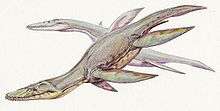Timeline of plesiosaur research
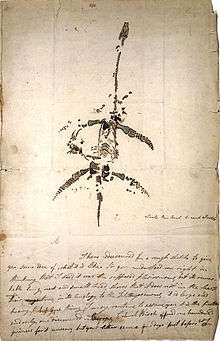
This timeline of plesiosaur research is a chronologically ordered list of important fossil discoveries, controversies of interpretation, taxonomic revisions, and cultural portrayals of plesiosaurs, an order of marine reptiles that flourished during the Mesozoic Era. The first scientifically documented plesiosaur fossils were discovered during the early 19th century by Mary Anning.[1] Plesiosaurs were actually discovered and described before dinosaurs.[2] They were also among the first animals to be featured in artistic reconstructions of the ancient world, and therefore among the earliest prehistoric creatures to attract the attention of the lay public.[3] Plesiosaurs were originally thought to be a kind of primitive transitional form between marine life and terrestrial reptiles. However, now plesiosaurs are recognized as highly derived marine reptiles descended from terrestrial ancestors.[4]
Early researchers thought that plesiosaurs laid eggs like most reptiles. They commonly imagined plesiosaurs crawling up beaches and burying eggs like turtles. However, later opinion shifted towards the idea that plesiosaurs gave live birth and never went on dry land.[5] Plesiosaur locomotion has been a source of continuous controversy among paleontologists.[6] The earliest speculations on the subject during the 19th century saw plesiosaur swimming as analogous to the paddling of modern sea turtles. During the 1920s opinion shifted to the idea that plesiosaurs swam with a rowing motion.[7] However, a paper published in 1975 that once more found support for sea turtle-like swimming in plesiosaurs.[8] This conclusion reignited the controversy regarding plesiosaur locomotion through the late 20th century.[9] In 2011, F. Robin O'Keefe and Luis M. Chiappe concluded the debate on plesiosaur reproduction, reporting the discovery of a gravid female plesiosaur with a single large embryo preserved inside her.[10]
Prescientific
Associated remains of plesiosaurs and animals like the diving bird Hesperornis or the pterosaur Pteranodon may have inspired legends about conflict between Thunder Birds and Water Monsters told by the Native Americans of Kansas and Nebraska.[11]
18th century
1719
- William Stukeley described the first partial skeleton of a plesiosaur, brought to his attention by the great-grandfather of Charles Darwin, Robert Darwin of Elston.[12]
19th century

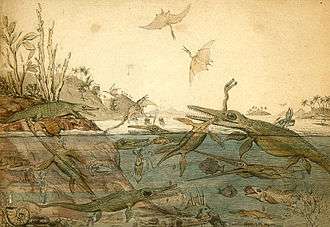
1810s
1811
- Mary Anning discovered some plesiosaur fossils in England.[1]
1820s
- Henry De la Beche and William Conybeare are the first to name a plesiosaurian species: Plesiosaurus dolichodeirus.[13]
1823
- Mary Anning finds the first relatively complete plesiosaur skeleton.[14]
1830s
- Buckland in Conybeare described the new species Plesiosaurus macrocephalus.[15]
- De la Beche illustrated a work titled "Duria Antiquior", meaning "A More Ancient Dorset" for fossil hunter Mary Anning. This work, which prominently features plesiosaurs, has been regarded as the first attempt to accurately reconstruct the Mesozoic world through an artistic medium.[3]
- von Meyer described Pistosaurus. Pistosaurus is believed to be a transitional form linking plesiosaurs to their basal sauropterygian forebears.[16]
1840s
- Owen described the species now known as Colymbosaurus trochanterius,[15] Eurycleidus arcuatus,[15] and Thalassiodracon hawkinsii.[17]
- Owen described the new species Pliosaurus brachydeirus,[15] Pliosaurus brachyspondylus.[15] and Polyptychodon interruptus.[15]
- Sir Richard Owen formally named the pliosaurs.[18]
- Stutchbury described the species now known as Atychodracon megacephalus.
1860s
.jpg)
- Carte and Bailey described the species now known as Rhomaleosaurus cramptoni.[15]
- Jules Verne depicted a relict plesiosaur's defeat in combat against an ichthyosaur in Journey to the Center of the Earth.[19]
- Owen described the species now known as Eretmosaurus rugosus[15] and Microcleidus homalospondylus.[15]
- Seeley described the species now known as Microcleidus macropterus.[15]
- Owen described the species now known as Archaeonectrus rostratus.[15]
- An army surgeon named Dr. Theophilus Turner discovered the fossils of a large animal in the Pierre Shale of Kansas, USA. The remains represented the first nearly complete plesiosaur specimen from North America. Turner gave some of its vertebrae to a member of the Union Pacific Railroad's survey named John LeConte. LeConte sent the vertebrae to Edward Drinker Cope for study. Cope recognized the find as a significant plesiosaur discovery and wrote to Turner asking him to excavate and ship the fossils to him.[20]
March, mid
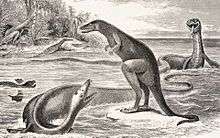
- Cope erected the new genus and species Elasmosaurus platyurus for the fossils sent by Turner in a rushed descriptive manuscript written within two weeks of obtaining them.[21]
March 24
- Cope presented his findings regarding Elasmosaurus to a meeting of the Academy of Natural Sciences in Philadelphia, Pennsylvania.[22]
- Cope described the new species Elasmosaurus platyurus.[15]
- Cope's description of Elasmosaurus was formally published.[22]
September
- William E. Webb and others collected and shipped a plesiosaur specimen to Cope.[23]

- Cope described the new species Polycotylus latipinnis.[15]
- Seeley described the species now known as Liopleurodon pachydeirus[15] and Peloneustes philarchus.[15]
- Cope named the plesiosaur specimen collected by Webb Polycotylus latipinnis.[23]
August
- Cope prepared a preprint for the Transactions of the American Philosophical Society of his Elasmosaurus description, including reconstruction of the animal with a short neck and very long tail. The manuscript was then distributed to other scholars.[22]
1870s

March 8
- Cope's mentor Joseph Leidy gave a presentation reporting his recent discovery that Cope's reconstruction of Elasmosaurus positioned the skull at the end of the tail rather than the end of the neck.[22]
- Leidy's discovery embarrassed Cope, who began spreading notice of an unspecified error in his Elasmosaurus description with an offer to replace it with a corrected version and its second volume.[24]
November
- O. C. Marsh collected a better an additional specimen of Polycotylus in Kansas that was better preserved than the type described by Cope. The specimen is now catalogued as YPM 1125.[25]

- Phillips described the species now known as Pliosaurus macromerus.[15]
- Phillips described the species now known as Cryptoclidus eurymerus.[15]
- Cope described the species now known as Hydralmosaurus serpentinus.[15]
- Cope inaccurately referred to Polycotylus as "the first true plesiosauroid found in America."[23]
- Cope imagined elasmosaurs feeding by craning their necks above the water and striking downward at fish long distances from their bodies.[26]
- B. F. Mudge discovered ten articulated vertebrae in the Fairport Chalk of Kansas that he mistook for ichthyosaur remains. These fossils are now catalogued as KUVP 1325.[27]

- Sauvage described the new species Liopleurodon ferox.[15]
- Joseph Savage discovered a second, better preserved Trinacromerum "anonymum" in Kansas.[27]

- Hector described the new species Mauisaurus haasti.[15]
- Seeley described the new species Muraenosaurus leedsi.[15]
- B. F. Mudge fragments of a large elasmosaur skeleton in the Fort Hays Limestone of Kansas.[28]
- Mudge and Williston excavated the remains another large Kansan plesiosaur, this one from the Smoky Hill Chalk.[28] The specimen may be a Styxosaurus snowii and is currently catalogued as YPM 1644. It was the first plesiosaur Mudge had ever found with gastroliths and the first plesiosaur encountered by Williston in general.[29]
- Hector reported the presence of elasmosaur remains in New Zealand.[30]
- Cope once more portrayed elasmosaurs as feeding by fishing from a distance with heads held above the waterline.[31]
- Blake in Tate and Blake described the new species Plesiosaurus longirostris.[15]
- Lydekker described the species now known as Simolestes indicus.[15]
- Mudge discussed the gastroliths of YPM 1644 in a scientific publication.[29] He concluded that plesiosaur exploited gastroliths to assist in breaking down food the way many modern birds and reptiles do.[32]
- Lydekker described the species now known as Cryptoclidus richardsoni.[15]
1880s
- Sollas described the species now known as Attenborosaurus conybeari.[15]

1884 Spring
- The Smithsonian bought a partial plesiosaur skeleton from Charles Sternberg. The specimen is now catalogued as USNM 4989 and would later serve as the type specimen of the new genus and species Brachauchenius lucasi.[33]
- Harry Seeley mistakenly claimed to have discovered several fossil plesiosaur embryos.[34]
- F. W. Cragin named the genus and species Trinacromerum bentonianum from Kansas.[35]
1890s
- In an article published in the New York Herald, Marsh brought up Cope's anatomic reversal of Elasmosaurus.[24]
- E. P. West excavated a skull and partial neck belonging to the elasmosaur that would come to be named Styxosaurus snowii. The specimen is now catalogued as KUVP 1301.[36]
- Williston described the species now known as Styxosaurus snowii.[15]
- Seeley described the species now known as Muraenosaurus beloclis.[15]

- Marsh described the new species Pantosaurus striatus.[17]
- Charles H. Sternberg obtained two large elasmosaur vertebrae that would later serve as the type specimen of Elasmosaurus sternbergi. The specimen is now catalogued as KUVP 1312.[37]
- F. W. Cragin discovered a partial plesiosaur skeleton and associated gastroliths in what is now recognized as the Kiowa Shale. This specimen is now catalogued as KUVP 1305 and would later be named Plesiosaurus mudgei.[38]
- Williston argued that plesiosaurs ingested gastroliths only accidentally or to relieve "food craving[s]".[32] However, he also observed that the rocks used as gastroliths were more similar to rocks 400–500 miles away in Iowa or the Black Hills of South Dakota than those of the local geology.[39]
- Cragin described the new species Plesiosaurus mudgei for KUVP 1305.[38]

- Dames described the species now known as Seeleysaurus guilelmiimperatoris.[15]
- With guidance from Edward Drinker Cope, paleo-artist Charles R. Knight illustrated an Elasmosaurus platyurus eating a fish. The elasmosaur's neck was erroneously looped into an anatomically impossible figure 8 configuration that evoked the image of "a python grasping at its prey".[40]
- Knight described the new species Megalneusaurus rex.[15]
- A man named Andrew Crombie discovered a fossil jaw fragment with six teeth in Queensland, Australia. The specimen would become the type for the genus Kronosaurus.[41]
20th century

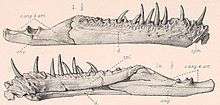
1900s
- Knight described the species now known as Tatenectes laramiensis.[17]
- George F. Sternberg discovered the plesiosaur specimen now known as KUVP 1300 that would later serve as the type specimen of Dolichorhynchops osborni.[42]
- Williston described the new species Dolichorhynchops osborni.[15]
- Williston made several changes to plesiosaur taxonomy. One of these was the description of the new genus and species Brachauchenius lucasi, whose type specimen was a partial skeleton discovered in Kansas. This specimen is now catalogued as USNM 4989.[33] He also described the new species Trinacromerum anonymum based on the vertebral series discovered by Mudge in 1872. This specimen is now known as KUVP 1325.[27] Lastly, Williston regarded Plesiosaurus mudgei as a junior synonym of the species Plesiosaurus gouldii.[38] He also commented on the ongoing debate regarding plesiosaur gastroliths, acknowledging the possibility that they were used for ballast while also maintaining openness to his 1893 suggestion that the stones were ingested accidentally.[43]
- Barnum Brown hypothesized that plesiosaurs used their gastroliths in a gizzard-like organ to grind up their invertebrate prey since they had no grinding or crushing teeth to do that job for them.[43]
- Harvard paleontologist Charles R. Eastman, "offended" by Brown's claim that plesiosaurs had a gizzard, criticized the idea in print.[43]
- Williston responded to Eastman, reasserting the evidence for plesiosaur gastroliths by noting that by this time at least 30 specimens containing them had been found.[44]
- Williston described several new taxa and specimens. One of these was the new species Elasmosaurus nobilis.[28] Williston also described the new Elasmosaurus species E. sternbergi based on the vertebrae discovered by Charles H. Sternberg in 1893. He remarked that these fossils were the largest elasmosaur vertebrae that he had ever seen.[37] Lastly, Williston described Marsh's Polycotylus, YPM 1125.[25]
- Williston reported the discovery of another Brachauchenius specimen, although this one was discovered in Texas.[45]
- Williston argued that Brachauchenius lucasi was closely related to Liopleurodon ferox.[46]
- Andrews described the new species Simolestes vorax.[15] and Tricleidus seeleyi.[15]
- Watson described the new species Sthenarasaurus dawkins.[15]
1910s

- Fraas described the species now known as Rhomaleosaurus victor.[15]
- Andrews described the species now known as Leptocleidus capensis.[15]
- Brown described the new species Leurospondylus' ultimus.[15]

- Williston criticized portrayals of long-necked plesiosaurs as having unnaturally flexible necks.[40]
- Wegner described the new species Brancasaurus brancai.[15]
- Williston observed that the semicircular canals inside a plesiosaur's ear were well developed, giving them a good sense of balance and coordination.[47]
- The Smithsonian obtained the Tylosaurus specimen with preserved polycotylid stomach contents from Charles Sternberg.[48] The Tylosaurus is catalogued as USNM 8898 and its last supper as USNM 9468.[49]
1920s
- Andrews described the new species Leptocleidus superstes.[15]
- Sternberg observed that being contained in the stomach of a mosasaur might have helped ensure the preservation of the polycotylid now known as USNM 9468 by protecting it from scavenging sharks.[49]
- Huene described the species now known as Hydrorion brachypterygius.[17]
- Heber Longman described Kronosaurus queenslandicus based on the jaw fragment found there by Andrew Crombie in 1899.[41]
- George F. Sternberg discovered a third specimen of Dolichorhynchops osborni in Kansas.[42]
- More Kronosaurus fossils were discovered in central Queensland near the site of the type specimen's discovery.[41]
1930s

- Swinton described the new species Macroplata tenuiceps.[15]
- George F. Sternberg and M. V. Walker discovered a well-preserved large elasmosaur specimen.[50]
- Harvard University dispatched a fossil hunting expedition to Queensland, Australia. In Army Downs they discovered a nearly complete specimen of Kronosaurus.[51]
- The "surgeon's photograph" of the Loch Ness monster was hoaxed, cementing the association between plesiosaurs and the mythical beast.[52]
c. 1935
- The University of Nebraska State Museum bought the elasmosaur specimen discovered by Sternberg and Walker in 1931. The specimen is now catalogued as UNSM 1195.[50]

- Russell described the new species Trinacromerum kirki.[15]
- A specimen of Trinacromerum was discovered in a roadside exposure of the Greenhorn Formation in Kansas. The specimen is now catalogued as KUVP 5070.[27]
- A large pliosaur skeleton was found on the banks of Russia's Volga River. However, the specimen was damaged during the excavation and only the skull and chest region were successfully extracted.[53]
1940s



- A complete specimen of Plesiosaurus conybeari, including preserved soft tissues, was destroyed in a bombing raid against Bristol. Fortunately, a cast of the specimen survived in the British Museum.[54]
- Cabrera described the new species Aristonectes parvidens.[15]
- Young described the new species Sinopliosaurus weiyuanensis.[17]
- Welles described the new species Aphrosaurus furlongi,[15] Morenosaurus stocki,[15] Thalassomedon haningtoni,[15] Fresnosaurus drescheri,[15] and Hydrotherosaurus alexandrae.[15]
- Welles argued that plesiosaurs did have flexible necks after all.[31]
- Elmer S. Riggs named a new species of Trinacromerum, T. willistoni. The type specimen had been found by a construction crew working on US Highway 81, who donated it to the University of Kansas Museum of Paleontology.[55]
- Riggs described the new species Trinacromerum willistoni based on the 1936 discovery KUVP 5070.[27]
- Soviet paleontologist Nestor Novozhilov described the Volga pliosaur as a new species, Pliosaurus rossicus.[53]
- Novozhilov described the species now known as Pliosaurus irgisensis.[15]
- Welles described the species now known as Libonectes morgani.[15]
- de la Torre and Rojas described the species now known as Vinielasaurus caroli.[17]
1950s

1950s
- Alfred Sherwood Romer helped mount the Kronosaurus discovered in Queensland by the 1930s Harvard expedition for the University's Museum of Comparative Zoology. The poorly preserved bones required a significant amount of plaster for the restoration, earning the specimen the mocking nickname "Plasterosaurus".[51] The final mount was 42 feet long, probably due to Romer overestimating the number of vertebrae in its spine; a more likely length is about 35 feet.[56]
- Fossil hunters Robert and Frank Jennrich serendipitously discovered a partial Brachauchenius skeleton whil looking for sharks teeth.[46]
- Shuler, like Williston in 1914, found elasmosaurs to have relatively inflexible necks.[31] He also found elasmosaurs to have stereoscopic vision, which would have been useful for hunting small prey.[47]
October
- George Sternberg excavated the Brachauchenius discovered by the Jennriches. This specimen, now known as FHSM VP-321, was both larger and better preserved than the Brachauchenius type specimen. Although it was put on display soon after discovery, it would not be described for the scientific literature for nearly 50 years.[46]
- Welles argued that the "Elasmosaurus sternbergi" type specimen was actually pliosaur vertebrae.[37]
- A private landowner in Kansas donated some Elasmosaurus vertebrae to the Sternberg Museum. These fossils are now catalogued as FHSM VP-398.[57]
1960s
- Tarlo described the new species Pliosaurus andrewsi.[15]
- Welles described the species now known as Callawayasaurus colombiensis.[17]
- Welles reported the presence of elasmosaur remains in South America.[30]
- Chatterjee and Zinsmeister reported the presence of elasmosaur remains in Antarctica.[30]
- Barney H. Newman and Lambert Beverly Halstead Tarlo argued that long-necked plesiosaur flippers could only move horizontally, and while maneuverable, they were confined to surface waters by an inability to dive.[58]
- South Australian opal miners John and Molly Addyman discovered a plesiosaur whose remains had been converted to opal].[59]
1970s
- Beverly Halstead reclassified the Volga pliosaur, Pliosaurus rossicus, to the genus Liopleurodon.[53]
- Paul Johnston discovered plesiosaur fossils in a roadside exposure of the Greenhorn Formation in Kansas.[60] During the excavation the dig site was scouted by two suspicious men. After a break from digging the Johnston team returned to find all of the fossils crudely extracted from the rock except for a flipper that the team had reburied. Based on the flipper, the stolen plesiosaur could be identified as Trinacromerum bentonianum.[61]

- Jane Ann Robinson published a paper on plesiosaur locomotion concluding that they really did swim by "underwater flight" like sea turtles or penguins.[8]
- Ochev described the species now known as Georgiasaurus penzensis.[15]
- Robinson publishes follow up research to her previous publication on plesiosaur locomotion.[9] This second paper notably concluded that plesiosaurs were incapable of leaving the water.[62]
1980s

- Dong described the new species Bishanopliosaurus youngi.[15]
- Michael Alan Taylor published a paper concluding that plesiosaurs would have been capable of moving on land after all because their spinal column was too arched for their lungs to collapse.[63]
- Brown described the new species Kimmerosaurus langhami.[15]
- Taylor argued that plesiosaurs used their gastroliths to adjust buoyancy or to help stay level and balanced while swimming.[32]
- Samuel F. Tarsitano and Jürgen Riess published a paper harshly critical of Robsinson's previous work on plesiosaur locomotion. However, while criticizing Robinson's work they were reluctant to make any positive claims of their own, concluding that the details of plesiosaur locomotion were "unknown".[9]
- Richard A. Thulborn published the results of his recent re-examination of the purported plesiosaur embryos discovered by Harry Govier Seeley. Thulborn concluded that Seeley's supposed embryos were actually nodules of mudstone and shale derived from sediments that once filled in a crustacean burrow system and were not even animal body fossils.[34]
- Delair described the new species Bathyspondylus swindoniensis.[17]
- The partial remains of a large pliosaur, initially mistaken for a dinosaur, were discovered near Aramberri, Mexico.[53]
- Zhang described the new species Yuzhoupliosaurus chengjiangensi.[17]
- A South Australian opal miner named Joe Vida discovered the skeleton of a juvenile plesiosaur whose remains had converted to opal. Its preparator, Paul Willis nicknamed it Eric. An entrepreneur named Sid Londish bought the specimen and funded its preparation, but went bankrupt. When the specimen was put up for auction fear spread that a potential buyer might break the specimen down for its gemstone value. A television drive was arranged on behalf of the Australian Museum. The Museum succeeded in raising 340,000 dollars to buy the specimen, whose gemstone value was about $300,000. Eric was later identified as a specimen of Leptocleidus.[18]

- Wiffen and Moisley described the new species Tuarangisaurus keysei.[17]
- Judith Massare published an analysis of plesiosaur feeding habits. She concluded that the long-necked plesiosauroids ate soft prey. Liopleurodon and its relatives, on the other hand, had teeth resembling those of killer whales and probably ate larger, bonier prey.[45]
- Orville Bonner discovered a specimen of Dolichorhynchops osborni that was later seen to preserve developing young inside it.[64]
- Judy Massare analyzed Mesozoic marine reptile swimming abilities and found that long-necked plesiosaurs would have been significantly slower than pliosaurs due to excess drag incurred from the length of the neck.[65]
- The Los Angeles County Museum of Natural History acquired the Dolichorhynchops osborni specimen discovered by Bonner and catalogued it as LACMNH 129639.[38]
- Beverly Halstead published a paper suggesting that plesiosaurs swam using all four flippers paired with an undulatory motion of the body comparable to a sea lion's.[66]
- Nakaya reported the presence of elasmosaur remains in Japan.[30]
1990s
- The world's smallest plesiosaur, between four and five feet in length, was discovered near Charmouth on the Dorset Coast.[67]
- Sciau et al. described the species now known as Occitanosaurus tournemirensis.[17]
- Gasparini and Spalleti described the new species Sulcusuchus erraini.[17]
- Stewart noted a relative paucity of plesiosaur fossils from the lower portions of the Smoky Hill Chalk in a manuscript for the Society of Vertebrate Paleontology.[68]
May
- J. D. Stewart, accompanied by Everhart, discovered a nearly complete Dolichorhynchops rear flipper in the lower Smoky Hill Chalk. Unfortunately it was too late to correct the erroneous statements in his aforementioned paper regarding the supposed rarity of plesiosaurs in the lower Smoky Hill Chalk. The flipper is now catalogued as LACMNH 148920.[69]

October
- Stewart's paper, complete with his now-erroneous statements, was published in the Niobrara Chalk Excursion Guidebook in honor of the society's 50th anniversary meeting in Lawrence that year.[68]
- Ralph E. Molnar published suspicion that the "Kronosaurus queenslandicus" specimen discovered by the Harvard expedition might actually be a distinct species.[41]
- Several Elasmosaurus vertebrae and gastroliths were found near the site where the type specimen of the genus itself was excavated.[57]
- Cruikshank and others hypothesized that plesiosaurs could smell and taste water that "passively" flowed through its nasal passages while they swam.[47]
- Hampe described the new species Kronosaurus boyacensis.[15]
- Everhart discovered some fragmentary plesiosaur fossils in the lower Smoky Hill Chalk of Kansas. Some of the fossils seemed to have been partially digested. The remains were later catalogued as FHSM VP-13966.[68]
- Everhart showed the partially digested fossils to J. D. Stewart, who recognized them as pieces of a plesiosaur skull. The fossils are now catalogued as [69]
- Everhart and his wife helped excavated a Styxosaurus snowii specimen in Kansas. During the dig Mrs. Everhart discovered an additional partial plesiosaur skeleton.[70]

- Robert T. Bakker nicknamed the long-necked plesiosaurs "swan lizards".[65]
- Robert T. Bakker argued that plesiosaurs suffered several major extinction events throughout the Mesozoic rather than continuously diversifying until the end-Cretaceous mass extinction.[71]
- Robert T. Bakker argued that Dolichorhynchops and its relatives became the most common kind of short-necked plesiosaur in the Cretaceous Western Interior Seaway after the ichthyosaurs became extinct. Further, they convergently evolved many traits similar to those of ichthyosaurs like long snouts and large eyes.[72]
- Tony Thulborn and Susan Turner examined the crushed skull of the long-necked plesiosaur Woolungasaurus and found the presence of tooth marks left by some giant predator. They hypothesized that a Kronosaurus was the culprit.[73]
- Storrs, like Williston and Shuler before him, argued that long-necked plesiosaurs had relatively inflexible necks.[31]
- Rothschild and Martin reported the presence of the remains of a fossilized fetus preserved in the abdomen of a Dolichorhynchops osborni.[74]
- Glenn W. Storrs formally described the world's smallest plesiosaur for the scientific literature.[67]
- South Dakota School of Mines paleontologist James Martin excavated and described a very young pliosaur specimen.[67] The specimen was located in what would have been the middle of the Cretaceous Western Interior Seaway. It is more plausible to think that this young individual was born in the seaway itself rather than surviving the extremely long swim from shore. So, the specimen provided circumstantial evidence for live birth and possibly even parental care by pliosaurs in the Cretaceous Western Interior Seaway.[75] However, since there were no adult fossils present this interpretation is speculative. Further, the fossil site had been heavily vandalized before discovery by scientists. A large hole was located near the baby pliosaur that could have once held the bones of its mother or other pod members.[76]


- An amateur fossil hunter named Simon Carpenter discovered a 7 foot long Pliosaurus brachyspondylus skull in the Blue Circle Cement Works of Westbury, England. More of the skeleton was found in the vicinity and this specimen came to be regarded as the best preserved pliosaur ever found.[77]
- A man named Alan Dawn discovered a previously unknown kind of pliosaur in the Middle Jurassic Oxford Clay of Cambridgeshire, England.[78]
- Godefroit described the new species Simolestes keileni.[15]
- Ken Carpenter recognized the plesiosaur specimen discovered by Pamela Everhart in 1992 as one of the largest known specimens of Dolichorhynchops osborni, now catalogued as CMC VP-7055.[70]
- Carpenter published a review of the Cretaceous short-necked plesiosaurs known from western North America. In this paper he both revised these plesiosaurs' taxonomy as well as offering observations on their biostratigraphy and evolution.[79] Carpenter described the new genus and species Plesiopleurodon wellesi.[17] He also argued against the prevailing trend to treat Dolichorhynchops Trinacromerum as taxonomic synonyms by observing that they could be distinguished based on their skull anatomy.[80] However he did conclude that the Trinacromerum species T. anonymum and T. willistoni were junior synonyms of T. bentonianum.[27]
In his remarks on short-necked plesiosaur evolution, Carpenter argued that polycotylids were more closely related to long-necked plesiosaurs than pliosaurs.[81] He observed that Trinacromerum bentonianum seems to have existed from the late Cenomanian to the Turonian. This represents a span of time approximating 3.3 million years. He found Dolichorhynchops osborni to have had an even longer lifespan, from the middle Turonian to the early Campanian., or roughly 4 million years. His research also suggested that there was a span of time during the life of the Western Interior Seaway in which it was not inhabited by polycotylids.[25]
He also reported that the Dolichorhynchops specimen KUVP 40001 from the Pierre Shale of South Dakota may have achieved the extraordinary length of 23 feet.[30] The large size of the Pierre Shale Dolichorhynchops compared to those of the earlier Smoky Hill Chalk suggested to Carpenter that these plesiosaurs were evolving larger body sizes over time. In fact the Pierre Shale specimens of Dolichorhynchops were nearly as large as Brachauchenius lucasi.[70] Carpenter described a particularly large specimen of that latter taxon in this paper as well, specifically FHSM VP-321.[46] His study of Brachauchenius led him to concur with Williston that it was closely related to Liopleurodon ferox.[46]
- Arthur R. I. Cruickshank, David M. Martill, and Leslie Noe formally named the new Oxford Clay pliosaur Pachycostasaurus dawni. The researchers noticed that its bones were very dense. So dense, they speculated it would naturally sink in the water and spent most of its time feeding on soft bodied animals living near the seafloor.[78]

- Cruickshank and Long described the new species Leptocleidus clemai'.[15]
- Gasparini described the new species Maresaurus coccai.[17]
- Liggett and others reported the discovery of a giant plesiosaur flipper from the Greenhorn Limestone of Kansas. Although a significant portion of the specimen was missing, it implied a life length of more than 2 m. The researchers tentatively attributed the flipper to Brachauchenius lucasi. The specimen is now catalogued as FHSM VP-13997.[70]
- Tamaki Sato and Kazushige Tanabe reported that a partial long necked plesiosaur skeleton had been discovered on the banks of Hokkaido's Obirashibe River. Although they could not identify its exact species, the specimen was significant because its stomach contents provided clues to long-necked plesiosaur diets. This individual's gut preserved the beaks of thirty small ammonites.[82]
- John A. Long bemoaned the fact that the putative "Kronosaurus queenslandicus" uncovered by a Harvard team during the early 1930s had still not been formally described for the scientific literature.[41]
- Michael Everhart and Glenn Storrs excavated additional Elasmosaurus ribs, vertebrae and gastroliths at the site of the 1991 discovery.[57]
- Long reported the presence of elasmosaur remains in Australia.[30]
- Carpenter published a summary of the elasmosaur fossils discovered in the Smoky Hill Chalk.[36]
- Storrs published a revision of Elasmosaurus taxonomy.[83] He reinterpreted the Elasmosaurus nobilis type specimen as indeterminate elasmosaurid remains.[28] He also reinterpreted the "Elasmosaurus" sternbergi type specimen as two cervical and one dorsal vertebrae rather than two dorsal vertebrae as Williston had reported in his original description. However, Storrs did agree that it was an elasmosaur specimen rather than a pliosaur as argued by Welles in 1952.[37]
21st century
2000s
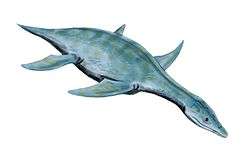

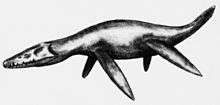
- Theagarten Lingham-Soliar published further criticism of Robinson's interpretation of the biomechanics of plesiosaur locomotion.[84]
- O'Keefe described the new species Hauffiosaurus zanoni.[17]
- Michael Everhart re-examined UNSM 1195.[50]
- Lingham-Soliar argued that plesiosaur hind-flippers weren't mobile or muscular enough to help propel them through the water.[85]
- Everhart published a study of the gastroliths associated with the elasmosaur specimen KUVP 129744 from Kansas. The specimen was associated with roughly 13.1 kg of gastroliths. The largest of these was 17 cm long and 1.4 kg in weight. Everhart would later compare its size to that of a softball and observe that not only was it one of the largest known plesiosaur gastroliths, but also one of the largest gastroliths from any animal.[32]
November
- The Advertiser, a newspaper based in Adelaide, Australia bought the Addyman opalized plesiosaur specimen for $25,000 and donated it to the South Australian Museum. A paleontologist at the museum named Ben Kear identified it as a member of the genus Leptocleidus. The two foot long specimen was the smallest specimen of the genus ever found and probably a baby.[59]
- David J. Cicimiurri and Michael J. Everhart published a study of the Styxosaurus snowii specimen NJSM 15435, which preserved both stomach contents and gastroliths.[32] Among the stomach contents were remains of the bony fish Enchodus.[47] By this point in time at least fifteen different plesiosaur specimens were known with preserved stomach contents.[86] The researchers observed that the Enchodus remains preserved in NJSM 15435 were an example of shifting dietary preferences in plesiosaurs, who fed primarily on cephalopods for most of their evolutionary history, before coming to rely more heavily on fishes during the Late Cretaceous.[47]
They also noted that some of NJSM 15435's gastroliths were scarred by rounded chips and arc-shaped marks. These were likely inflicted by contact with other gastroliths during the churning of the animal's stomach, and constituted physical evidence that plesiosaurs used their gastroliths to help break down their food during digestion.[87] Cicimurri and Everhart disputed the hypothesis that plesiosaurs used their gastroliths for ballast on the grounds that swallowing and vomiting such stones would be relatively difficult for the long-necked forms and their feeding grounds may have been hundreds of miles from sources of stones.[88]
- Everhart resumed the study of the partially digested plesiosaur skull bones, FHSM VP-13966. He sought the expertise of Ken Carpenter due to his relevant 1996 paper on short-necked plesiosaurs. Carpenter identified the bones as probable Dolichorhynchops remains.[27]
- Noe published another study of Pachycostasaurus. He changed his mind regarding its diet. Where previously he believed it to feed on soft-bodied animals, the robust and "heavily ornamented" build of its teeth suggested it fed on harder, bonier prey.[78]

September
- Eberhard Frey, Celine Bachy, and Wolfgang Stinnesbeck gave a presentation on the Aramberri pliosaur remains to the European Workshop on Vertebrate Paleontology in Florence, Italy. The paleontologists could not identify its species.[89]
September 11
- Everhart was forced to cancel plans to examined the Tylosaurus specimen USNM 8898 and its polycotylid dinner USNM 9468 due to the September 11th terrorist attacks.[49]
November
- Everhart was finally able to examine the tylosaur specimen with the polycotylid stomach contents.[49]

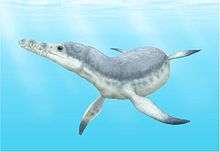
2001–2002
- Robin O'Keefe publishes a series of papers examining the aspect ratios of plesiosaur flippers and comparing them to the wings of birds, bats, and aircraft. O'Keefe concluded that long-necked plesiosaurs were long distance swimmers, while pliosaurs were more maneuverable.[90]
- Cruickshank and Fordyce described the new species Kaiwhekea katiki.[17]
- Druckenmiller described the new species Edgarosaurus muddi.[17]
- Michael Everhart examined FHSM VP-398 and found Sternberg's original note revealing that these fossils had been collected at the same site as the 1991 Elasmosaurus discovery. Everhart realized that the remains discovered there collectively represented most of the bones that had been missing from the Elasmosaurus type specimen. He inferred that they may represent fragments that fell off of the decomposing type carcass while it was adrift, before its final burial and fossilization.[57]
- An elasmosaur specimen with over 600 associated gastroliths was discovered in the Pierre Shale of Nebraska. The specimen is now catalogued as UNSM 1111-002.[32]
December 30
- The BBC began making sensational claims about the Aramberri pliosaur, claiming that the unidentified pliosaur was a Liopleurodon, that it was 65 feet long, that its teeth were the size of machetes, and its jaws powerful enough to crush granite.[91]
- The University of Nebraska led the excavation of a long-necked plesiosaur skeleton on local Santee Sioux land.[92] The Santee people requested that the skeleton be mounted and displayed with a plaque acknowledging them as the source of the fossils and as having given permission for the museum to display the remains. However, the museum claims it could not honor the request as it did not have the funding to mount the skeleton for display, and it further claimed that the land the fossils were recovered from was of "disputed" ownership.[93]
- Mulder and others reported the presence of elasmosaur remains in Europe.[30]

- Sato described the new genus and species Terminonatator ponteixensis. In his study of the animal's skeleton, he found that the vertebral discs in the neck were flat on both sides and packed tightly together. He estimated that there would have been only about 0.5 cm of cartilaginous padding between these discs. These observations provided additional evidence for a lack of flexibility in plesiosaur necks.[31]
- Everhart argued contrary to Carpenter's 1996 paper that polycotylids were present throughout the life of the Western Interior Seaway.[42]
- Everhart finally described the partially digested partial plesiosaur skull he discovered in 1992. These were among the earliest known plesiosaur fossils in the Smoky Hill Chalk. He has since concluded that the animal that partially digested the remains was probably a shark, which would go on to vomit them up before they were buried and preserved.[69]
- Bardet and others described the new species Thililua longicollis.[17]
- Sato described the new species Terminonatator ponteixensis.[17]
- Michael Everhart found Charles H. Sternberg's account of the discovery of the Elasmosaurus sternbergi type specimen in his 1932 book. This allowed Everhart to verify the specimen's geographic and stratigraphic provenence.[94]
- Everhart argued that the greater abundance of arc shaped marks and rounded divots in plesiosaur gastroliths compared to rocks deposited by ancient rivers and sea shores was evidence for their use in the breakdown of plesiosaurs' food.[87]
- Everhart redescribed the Tylosaurus specimen USNM 8898 and its polycotylid dinner USNM 9468. Contrary to Sternberg's original assessment of the stomach contents as representing a "huge plesiosaur" Everhart found it to be a young polycotylid only about 2-2.5 m long.[49]
- Noe et al. described the new species Pliosaurus portentificus.[15]

- Sato described the new species Dolichorhynchops herschelensis.[15]
- Sachs described the species now known as Eromangasaurus australis.[17]
- Buchy et al. described the new species Manemergus anguirostris.[17]

- Buchy described the new species Libonectes atlasense.[15]
- Kear described the new species Umoonasaurus demoscyllus.[17]
- Kear described the new species Opallionectes andamookaensis.[17]
- Sato et al. described the new species Futabasaurus suzukii.[17]
- Albright et al. described the new species Eopolycotylus rankini.[17]
- Albright et al. described the new species Palmula quadratus.[17]
2010s

- Sennikov and Arkhangelsky described the new genus and species Alexeyisaurus karnoushenkoi.[95]
- Smith and Vincent described the new genus Meyerasaurus.[96]
- F. Robin O'Keefe and Luis M. Chiappe concluded the debate on plesiosaur reproduction, reporting the discovery of a gravid female plesiosaur with a single large embryo preserved inside her. They concluded that like marine mammals, but unlike many reptiles, plesiosaurs had a K-selected reproductive strategy.[10]
- Berezin described the new genus and species Abyssosaurus nataliae[97]
- Benson and others described the new species Hauffiosaurus tomistomimus[98]
- Ketchum and Benson described the new genus and species Marmornectes candrewi[99]
- Schwermann and Sander described the new genus and species Westphaliasaurus simonsensii [100]
- Vincent and others described the new genus and species Zarafasaura oceanis[101]

- Kubo, Mitchell and Henderson described the new genus and species Albertonectes vanderveldei.[102]
- Vincent and Benson described the new genus and species Anningasaura lymense.[103]
- Benson, Evans and Druckenmiller described the new genera and species Avalonnectes arturi, Eoplesiosaurus antiquior, and Stratesaurus taylori.[104]
- Knutsen, Druckenmiller and Hurum described the new genus and species Djupedalia engeri.[105]
- McKean described the new species Dolichorhynchops tropicensis.[106]
- Benson and others described the new genus Hastanectes and the new genus and species Vectocleidus pastorum.[107]
- Smith, Araújo and Mateus described the new genus and species Lusonectes sauvagei.[108]
- Knutsen, Druckenmiller and Hurum described the new species Pliosaurus funkei[109]
- Knutsen, Druckenmiller and Hurum described the new genus Spitrasaurus and two species, S. wensaasi, and S. larseni.[110]

- Vincent, Bardet and Mattioli described the new genus and species Cryonectes neustriacus[111]
- Hampe described the new genus and species Gronausaurus wegneri[112]
- Schumacher, Carpenter and Everhart described the new genus and species Megacephalosaurus eulerti[113]
- Benson and others described the new Pliosaurus species P. carpenteri, P. kevani, and P. westburyensis.[114]
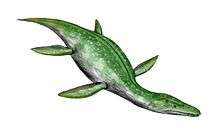
- Otero and others described the new species Aristonectes quiriquinensis.[115]
- Gasparini and O’Gorman described the new species Pliosaurus patagonicus.[116]
- Cau and Fanti described the new genus and species Anguanax zignoi.[117]
- Smith described the new genus Atychodracon.[118]
- Araújo and others described the new genus and species Cardiocorax mukulu.[119]
- O’Gorman and others described the new genus and species Vegasaurus molyi.[120]
- Otero and others described the new genus and species Alexandronectes zealandiensis.
- O’Gorman described the new genus Kawanectes.
- Páramo and others described the new genus and species Stenorhynchosaurus munozi.[121]
- Cheng and others described the new genus Dawazisaurus.
- Klein and others described the new species Lariosaurus vosseveldensis.
- Efimov, Meleshin and Nikiforov described the new species Polycotylus sopozkoi.
See also
- History of paleontology
- Timeline of ichthyosaur research
- List of plesiosaurs
- Marine reptile
- Mosasaur
- Timeline of paleontology
Footnotes
- 1 2 Ellis (2003); "Introduction: Isn't That the Loch Ness Monster?", page 3.
- ↑ Ellis (2003); "The Marine Reptiles: An Overview", page 20.
- 1 2 Ellis (2003); "The Marine Reptiles: An Overview", page 21.
- ↑ Ellis (2003); "The Plesiosaurs", page 118.
- ↑ Ellis (2003); "The Plesiosaurs", page 119.
- ↑ Ellis (2003); "The Plesiosaurs", page 136.
- ↑ Ellis (2003); "The Plesiosaurs", page 137.
- 1 2 Ellis (2003); "The Plesiosaurs", page 138.
- 1 2 3 Ellis (2003); "The Plesiosaurs", page 139.
- 1 2 O'Keefe and Chiappe (2011); "Abstract", page 870.
- ↑ For the mythical creatures as Thunder Birds and Water Monsters, see Mayor (2005); "The Stone Medicine Bone, Pawnee Territory", page 178. For plesiosaurs as a specific source of these legends, see Mayor (2005); "Cheyenne Fossil Knowledge", page 211.
- ↑ Stukeley (1791); in passim.
- ↑ Ellis (2003); "The Plesiosaurs", page 123.
- ↑ Conybeare, W.D., 1824, "On the discovery of an almost perfect skeleton of the Plesiosaurus", Transactions of the Geological Society of London 2: 382-389
- 1 2 3 4 5 6 7 8 9 10 11 12 13 14 15 16 17 18 19 20 21 22 23 24 25 26 27 28 29 30 31 32 33 34 35 36 37 38 39 40 41 42 43 44 45 46 47 48 49 50 51 52 53 54 55 56 57 58 Smith (2007); "Appendix 1", page 257.
- ↑ Ellis (2003); "The Marine Reptiles: An Overview", page 37.
- 1 2 3 4 5 6 7 8 9 10 11 12 13 14 15 16 17 18 19 20 21 22 23 24 25 26 Smith (2007); "Appendix 1", page 258.
- 1 2 Ellis (2003); "The Pliosaurs", page 166.
- ↑ Ellis (2003); "The Marine Reptiles: An Overview", pages 21-22.
- ↑ Everhart (2005); "Where the Elasmosaurs Roamed", page 121.
- ↑ Everhart (2005); "Where the Elasmosaurs Roamed", pages 121–122.
- 1 2 3 4 Everhart (2005); "Where the Elasmosaurs Roamed", page 122.
- 1 2 3 Everhart (2005); "Pliosaurs and Polycotylids", pages 146–147.
- 1 2 Everhart (2005); "Where the Elasmosaurs Roamed", page 123.
- 1 2 3 Everhart (2005); "Pliosaurs and Polycotylids", page 147.
- ↑ Everhart (2005); "Where the Elasmosaurs Roamed", pages 130-132.
- 1 2 3 4 5 6 7 Everhart (2005); "Pliosaurs and Polycotylids", page 150.
- 1 2 3 4 Everhart (2005); "Where the Elasmosaurs Roamed", page 128.
- 1 2 Everhart (2005); "Where the Elasmosaurs Roamed", pages 128-129.
- 1 2 3 4 5 6 7 Everhart (2005); "Where the Elasmosaurs Roamed", page 129.
- 1 2 3 4 5 Everhart (2005); "Where the Elasmosaurs Roamed", page 132.
- 1 2 3 4 5 6 Everhart (2005); "Where the Elasmosaurs Roamed", page 137.
- 1 2 Everhart (2005); "Pliosaurs and Polycotylids", pages 151–152.
- 1 2 Ellis (2003); "The Plesiosaurs", page 149.
- ↑ Ellis (2003); "The Pliosaurs", pages 188–189.
- 1 2 Everhart (2005); "Where the Elasmosaurs Roamed", page 125.
- 1 2 3 4 Everhart (2005); "Where the Elasmosaurs Roamed", page 126.
- 1 2 3 4 Everhart (2005); "Pliosaurs and Polycotylids", page 154.
- ↑ Everhart (2005); "Where the Elasmosaurs Roamed", page 138.
- 1 2 Ellis (2003); "The Plesiosaurs", page 153.
- 1 2 3 4 5 Ellis (2003); "The Pliosaurs", page 176.
- 1 2 3 Everhart (2005); "Pliosaurs and Polycotylids", page 148.
- 1 2 3 Ellis (2003); "The Plesiosaurs", page 156.
- ↑ Ellis (2003); "The Plesiosaurs", pages 156–157.
- 1 2 Ellis (2003); "The Pliosaurs", page 184.
- 1 2 3 4 5 Everhart (2005); "Pliosaurs and Polycotylids", page 152.
- 1 2 3 4 5 Everhart (2005); "Where the Elasmosaurs Roamed", page 134.
- ↑ Everhart (2005); "Pliosaurs and Polycotylids", pages 144–145.
- 1 2 3 4 5 Everhart (2005); "Pliosaurs and Polycotylids", page 145.
- 1 2 3 Everhart (2005); "Where the Elasmosaurs Roamed", page 127.
- 1 2 Ellis (2003); "The Pliosaurs", page 175.
- ↑ Ellis (2003); "The Plesiosaurs", page 121.
- 1 2 3 4 Ellis (2003); "The Pliosaurs", page 181.
- ↑ Ellis (2003); "The Plesiosaurs", page 161.
- ↑ Ellis (2003); "The Pliosaurs", page 188.
- ↑ Ellis (2003); "The Pliosaurs", pages 175–176.
- 1 2 3 4 Everhart (2005); "Where the Elasmosaurs Roamed", page 124.
- ↑ Ellis (2003); "The Plesiosaurs", page 154.
- 1 2 Ellis (2003); "The Pliosaurs", page 174.
- ↑ Everhart (2005); "Pliosaurs and Polycotylids", pages 150–151.
- ↑ Everhart (2005); "Pliosaurs and Polycotylids", page 151.
- ↑ Ellis (2003); "The Plesiosaurs", pages 139–140.
- ↑ Ellis (2003); "The Plesiosaurs", page 142.
- ↑ Everhart (2005); "Pliosaurs and Polycotylids", pages 153–154.
- 1 2 Ellis (2003); "The Plesiosaurs", page 152.
- ↑ Ellis (2003); "The Plesiosaurs", page 143.
- 1 2 3 Ellis (2003); "The Plesiosaurs", page 150.
- 1 2 3 Everhart (2005); "Pliosaurs and Polycotylids", pages 149–150.
- 1 2 3 Everhart (2005); "Pliosaurs and Polycotylids", page 149.
- 1 2 3 4 Everhart (2005); "Pliosaurs and Polycotylids", page 153.
- ↑ Ellis (2003); "The Plesiosaurs", page 163.
- ↑ Ellis (2003); "The Pliosaurs", pages 189–191.
- ↑ Ellis (2003); "The Pliosaurs", page 176. For the original paper, see Thulborn and Turner (1993).
- ↑ Everhart (2005); "Where the Elasmosaurs Roamed", pages 139–140.
- ↑ Ellis (2003); "The Plesiosaurs", pages 150–151.
- ↑ Ellis (2003); "The Plesiosaurs", page 151.
- ↑ Ellis (2003); "The Pliosaurs", page 169.
- 1 2 3 Ellis (2003); "The Pliosaurs", page 191.
- ↑ Carpenter (1996); in passim.
- ↑ Ellis (2003); "The Pliosaurs", page 189.
- ↑ Everhart (2005); "Pliosaurs and Polycotylids", page 144.
- ↑ Ellis (2003); "The Plesiosaurs", pages 155–156.
- ↑ Storrs (1999); in passim.
- ↑ Ellis (2003); "The Plesiosaurs", page 141.
- ↑ Everhart (2005); "Where the Elasmosaurs Roamed", page 135.
- ↑ Ellis (2003); "The Plesiosaurs", page 155.
- 1 2 Everhart (2005); "Where the Elasmosaurs Roamed", page 139.
- ↑ Ellis (2003); "The Plesiosaurs", page 159.
- ↑ Ellis (2003); "The Pliosaurs", pages 181–182.
- ↑ Ellis (2003); "The Plesiosaurs", pages 142–143.
- ↑ Ellis (2003); "The Pliosaurs", page 182.
- ↑ Mayor (2005); "Cultural and Historical Conflicts", page 303.
- ↑ Mayor (2005); "Cultural and Historical Conflicts", pages 303–304.
- ↑ Everhart (2005); "Where the Elasmosaurs Roamed", page 126–127.
- ↑ Sennikov and Arkhangelsky (2010); in passim.
- ↑ Smith and Vincent (2010); in passim.
- ↑ Berezin (2011); in passim.
- ↑ Benson and others (2011); in passim.
- ↑ Ketchum and Benson (2011); in passim.
- ↑ Schwermann and Sander (2011); in passim.
- ↑ Vincent et al. (2011); in passim.
- ↑ Kubo, Mitchell and Henderson (2012); in passim.
- ↑ Vincent and Benson (2012); in passim.
- ↑ Benson, Evans and Druckenmiller (2012); in passim.
- ↑ Knutsen, Druckenmiller and Hurum "A New Pleiosauroid..." (2012); in passim.
- ↑ McKean (2012); in passim.
- ↑ Benson et al. (2012); in passim.
- ↑ Smith, Araújo and Mateus (2012); in passim.
- ↑ Knutsen, Druckenmiller and Hurum "A New Species of Pliosaurus..." (2012); in passim.
- ↑ Knutsen, Druckenmiller and Hurum "Two New Species of..."(2012); in passim.
- ↑ Vincent, Bardet, and Mattioli (2013); in passim.
- ↑ Hampe (2013); in passim.
- ↑ Schumacher, Carpenter and Everhart (2013); in passim.
- ↑ Benson et al. (2013); in passim.
- ↑ Otero et al. (2014); in passim.
- ↑ Gasparini and O’Gorman et al. (2014); in passim.
- ↑ Cau and Fanti (2015); in passim.
- ↑ Smith (2015); in passim.
- ↑ Araujo et al. (2015); in passim.
- ↑ O’Gorman et al. (2015); in passim.
- ↑ Páramo, María E.; Gómez-Pérez, Marcela; Noé, Leslie F.; Etayo, Fernando (2016-04-06). "Stenorhynchosaurus munozi, gen. et sp. nov. a new pliosaurid from the Upper Barremian (Lower Cretaceous) of Villa de Leiva, Colombia, South America". Revista de la Academia Colombiana de Ciencias Exactas, Físicas y Naturales. 40 (154): 84–103. doi:10.18257/raccefyn.239. ISSN 2382-4980.
References
- R. Araújo; M.J. Polcyn; A.S. Schulp; O. Mateus; L.L. Jacobs; A. Olímpio Gonçalves & M.-L. Morais (2015). "A new elasmosaurid from the early Maastrichtian of Angola and the implications of girdle morphology on swimming style in plesiosaurs". Netherlands Journal of Geosciences - Geologie en Mijnbouw. 94 (1): 109–120. doi:10.1017/njg.2014.44.
- Roger B. J. Benson; Mark Evans & Patrick S. Druckenmiller (2012). "High Diversity, Low Disparity and Small Body Size in Plesiosaurs (Reptilia, Sauropterygia) from the Triassic–Jurassic Boundary". PLoS ONE. 7 (3): e31838. doi:10.1371/journal.pone.0031838. PMC 3306369
 . PMID 22438869.
. PMID 22438869. - Roger B. J. Benson; Mark Evans; Adam S. Smith; Judyth Sassoon; Scott Moore-Faye; Hilary F. Ketchum & Richard Forrest (2013). "A Giant Pliosaurid Skull from the Late Jurassic of England". PLoS ONE. 8 (5): e65989. doi:10.1371/journal.pone.0065989.
- Roger B. J. Benson; Hilary F. Ketchum; Darren Naish & Langan E. Turner (2013). "A new leptocleidid (Sauropterygia, Plesiosauria) from the Vectis Formation (Early Barremian–early Aptian; Early Cretaceous) of the Isle of Wight and the evolution of Leptocleididae, a controversial clade". Journal of Systematic Palaeontology. 11 (2): 233–250. doi:10.1080/14772019.2011.634444.
- Roger B. J. Benson; Hilary F. Ketchum; Leslie F. Noè & Marcela Gómez-Pérez (2011). "New information on Hauffiosaurus (Reptilia, Plesiosauria) based on a new species from the Alum Shale Member (Lower Toarcian: Lower Jurassic) of Yorkshire, UK". Palaeontology. 54 (3): 547–571. doi:10.1111/j.1475-4983.2011.01044.x.
- A. Yu. Berezin (2011). "A new plesiosaur of the family Aristonectidae from the early cretaceous of the center of the Russian platform". Paleontological Journal. 45 (6): 648–660. doi:10.1134/S0031030111060037.
- Carpenter K. 1996. A review of short-necked plesiosaurs from the Cretaceous of the Western Interior, North America. Neues Jahrbuch für Geologie und Paläontologie, Abhandlungen 210 (2): 259–287.
- Andrea Cau & Federico Fanti (2015). "High evolutionary rates and the origin of the Rosso Ammonitico Veronese Formation (Middle-Upper Jurassic of Italy) reptiles". Historical Biology: An International Journal of Paleobiology. Online edition. doi:10.1080/08912963.2015.1073726.
- Ellis, Richard, (2003) Sea Dragons - Predators of the Prehistoric Oceans. University Press of Kansas. ISBN 0-7006-1269-6.
- Everhart, Michael J. Oceans Of Kansas: A Natural History Of The Western Interior Sea (Life of the Past). Bloomington: Indiana University Press, 2005. 322 pp.
- Zulma Gasparini & José P. O'Gorman (2014). "A new species of Pliosaurus (Sauropterygia, Plesiosauria) from the Upper Jurassic of northwestern Patagonia, Argentina". Ameghiniana. 51 (4): 269–283. doi:10.5710/amgh.03.04.2014.2225.
- Oliver Hampe (2013). "The forgotten remains of a leptocleidid plesiosaur (Sauropterygia: Plesiosauroidea) from the Early Cretaceous of Gronau (Münsterland, Westphalia, Germany)". Paläontologische Zeitschrift. 87 (4): 473–491. doi:10.1007/s12542-013-0175-3.
- Hilary F. Ketchum & Roger B. J. Benson (2011). "A new pliosaurid (Sauropterygia, Plesiosauria) from the Oxford Clay Formation (Middle Jurassic, Callovian) of England: evidence for a gracile, longirostrine grade of Early-Middle Jurassic pliosaurids". Special Papers in Palaeontology. 86: 109–129. doi:10.1111/j.1475-4983.2011.01083.x.
- Espen M. Knutsen; Patrick S. Druckenmiller & Jørn H. Hurum (2012). "A new species of Pliosaurus (Sauropterygia: Plesiosauria) from the Middle Volgian of central Spitsbergen, Norway" (PDF). Norwegian Journal of Geology. 92 (2–3): 235–258.
- Espen M. Knutsen; Patrick S. Druckenmiller & Jørn H. Hurum (2012). "A new plesiosauroid (Reptilia: Sauropterygia) from the Agardhfjellet Formation (Middle Volgian) of central Spitsbergen, Norway" (PDF). Norwegian Journal of Geology. 92 (2–3): 213–234.
- Espen M. Knutsen; Patrick S. Druckenmiller & Jørn H. Hurum (2012). "Two new species of long-necked plesiosaurians (Reptilia: Sauropterygia) from the Upper Jurassic (Middle Volgian) Agardhfjellet Formation of central Spitsbergen" (PDF). Norwegian Journal of Geology. 92 (2–3): 187–212.
- Tai Kubo; Mark T. Mitchell & Donald M. Henderson (2012). "Albertonectes vanderveldei, a new elasmosaur (Reptilia, Sauropterygia) from the Upper Cretaceous of Alberta". Journal of Vertebrate Paleontology. 32 (3): 557–572. doi:10.1080/02724634.2012.658124.
- Mayor, Adrienne. Fossil Legends of the First Americans. Princeton University Press. 2005. ISBN 0-691-11345-9.
- José P. O’Gorman; Leonardo Salgado; Eduardo B. Olivero & Sergio A. Marenssi (2015). "Vegasaurus molyi, gen. et sp. nov. (Plesiosauria, Elasmosauridae), from the Cape Lamb Member (lower Maastrichtian) of the Snow Hill Island Formation, Vega Island, Antarctica, and remarks on Wedellian Elasmosauridae". Journal of Vertebrate Paleontology. 35 (3): e931285. doi:10.1080/02724634.2014.931285.
- O'Keefe, F.R.; Chiappe, L.M. (2011). "Viviparity and K-selected life history in a Mesozoic marine plesiosaur (Reptilia, Sauropterygia)". Science. 333 (6044): 870–873. doi:10.1126/science.1205689. PMID 21836013.
- Rodrigo A. Otero; Sergio Soto-Acuña; Frank Robin O'Keefe; José P. O’Gorman; Wolfgang Stinnesbeck; Mario E. Suárez; David Rubilar-Rogers; Christian Salazar & Luis Arturo Quinzio-Sinn (2014). "Aristonectes quiriquinensis, sp. nov., a new highly derived elasmosaurid from the upper Maastrichtian of central Chile". Journal of Vertebrate Paleontology. 34 (1): 100–125. doi:10.1080/02724634.2013.780953.
- Rebecca Schmeisser McKean (2012). "A new species of polycotylid plesiosaur (Reptilia: Sauropterygia) from the Lower Turonian of Utah: extending the stratigraphic range of Dolichorhynchops". Cretaceous Research. 34: 184–199. doi:10.1016/j.cretres.2011.10.017.
- A. G. Sennikov; M. S. Arkhangelsky (2010). "On a Typical Jurassic Sauropterygian from the Upper Triassic of Wilczek Land (Franz Josef Land, Arctic Russia)". Paleontological Journal. 44 (5): 567–572. doi:10.1134/S0031030110050126.
- Leonie Schwermann & Martin Sander (2011). "Osteologie und Phylogenie von Westphaliasaurus simonsensii: Ein neuer Plesiosauride (Sauropterygia) aus dem Unteren Jura (Pliensbachium) von Sommersell (Kreis Höxter), Nordrhein-Westfalen, Deutschland [=Osteology and Phylogeny of Westphaliasaurus simonsensii, a new plesiosaurid (Sauropterygia) from the Lower Jurassic (Pliensbachian) of Sommersell (Höxter district), North Rhine-Westphalia, Germany]". Geologie und Paläontologie in Westfalen. 79 (1): 56 pp. ISBN 978-3-940726-14-8.
- Smith, Adam Stuart. 2007. Anatomy and Systematics of the Rhomaleosauridae (Sauropterygia:Plesiosauria). Ph.D thesis. University of Ireland. 278 p.
- Adam S. Smith; Peggy Vincent (2010). "A new genus of pliosaur (Reptilia: Sauropterygia) from the Lower Jurassic of Holzmaden, Germany". Palaeontology. 53 (5): 1049–1063. doi:10.1111/j.1475-4983.2010.00975.x.
- Adam S. Smith; Ricardo Araújo & Octávio Mateus (2012). "Lusonectes sauvagei, a new plesiosauroid from the Toarcian (Lower Jurassic) of Alhadas, Portugal". Acta Palaeontologica Polonica. 57 (2): 257–266. doi:10.4202/app.2011.0023.
- Adam S. Smith (2015). "Reassessment of 'Plesiosaurus' megacephalus (Sauropterygia: Plesiosauria) from the Triassic-Jurassic boundary, UK". Palaeontologia Electronica. 18 (1): Article number 18.1.20A.
- Storrs, G. W. 1999. An examination of Plesiosauria (Diapsida: Sauropterygia) from the Niobrara Chalk (upper Cretaceous) of central North America. Univ. Kansas Paleont. Cont. (New Ser.), (11):15 pp.
- Stukeley, W., 1719, "An account of the impression of the almost entire sceleton of a large animal in a very hard stone, lately presented the Royal Society, from Nottinghamshire", Philosophical Transactions, 30: 963-968.
- Thulborn, T; Turner, S (1993). "An elasmosaur bitten by a pliosaur". Modern Geology. 18: 489–501.
- Peggy Vincent; Nathalie Bardet & Emanuela Mattioli (2013). "A new pliosaurid from the Pliensbachian (Early Jurassic) of Normandy (Northern France)". Acta Palaeontologica Polonica. 58 (3): 471–485. doi:10.4202/app.2011.0113.
- Peggy Vincent & Roger B. J. Benson (2012). "Anningasaura, a basal plesiosaurian (Reptilia, Plesiosauria) from the Lower Jurassic of Lyme Regis, United Kingdom". Journal of Vertebrate Paleontology. 32 (5): 1049–1063. doi:10.1080/02724634.2012.686467.
- Peggy Vincent; Nathalie Bardet; Xabier Pereda Suberbiola; Baâdi Bouya; Mbarek Amaghzaz & Saïd Meslouh (2011). "Zarafasaura oceanis, a new elasmosaurid (Reptilia: Sauropterygia) from the Maastrichtian Phosphates of Morocco and the palaeobiogeography of latest Cretaceous plesiosaurs". Gondwana Research. 19 (4): 1062–1073. doi:10.1016/j.gr.2010.10.005.
External links
-
 Media related to Plesiosauria at Wikimedia Commons
Media related to Plesiosauria at Wikimedia Commons

